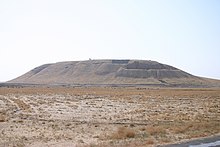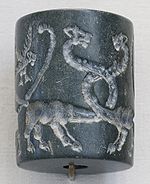Tel (arkeologi)


Dalam arkeologi, tel atau tell (daripada Arab: تَلّcode: ar is deprecated , tal, 'cangkat', 'guar' atau 'anak bukit')[1] ialah sejenis topografi buatan manusia. Ia merupakan guar yang terhasil apabila endapan, debu, sampah, tanah dan sebagainya terkumpul daripada sesuatu kaum yang tinggal di penempatan sama secara turun-temurun, menyebabkan muka bumi menjadi tinggi.[2][3][4][5]
Tel biasanya dikaitkan dengan rantau Barat Jauh Asia kuno tetapi ia juga ditemui di tempat lain, seperti Eropah Selatan dan sebahagian Tengah, dari Yunani dan Bulgaria ke Hungary dan Sepanyol[6][7] dan Afrika Utara.[3][8][9][10] Di Barat Jauh, tel paling banyak di kawasan yang kurang gersang, seperti Mesopotamia Hilir, Syam Selatan, Anatolia dan Iran, yang semuanya diduduki dengan agak lama.[11] Tel-tel Eurasia berasal dari zaman Neolitik,[12] Tembaga, Gangsa dan Besi.[13] Di Syam Selatan, zaman tel terhenti apabila Alexander Agung datang menakluk, yang memulakan zaman Helenistik dengan corak membina penempatan yang berbeza.[perlu rujukan] Banyak tel di seluruh Barat Jauh terus diduduki dan digunakan hari ini.[14]
Etimologi
Perkataan tel memasuki bahasa Melayu menerusi Inggeris, yang kali pertama dibuktikan penggunaannya pada tahun 1840 dalam Journal of the Royal Geographical Society.[15] Ia berasal daripada bahasa Arab تَلّcode: ar is deprecated (tal ) bermaksud 'guar', 'anak bukit' atau 'cangkat'.[1][15] Ejaan lain termasuk tall, tel, til dan tel.[16]
Tel mempunyai banyak kata seasal dalam bahasa Semitik lain, seperti bahasa Akkadia tīlu(m), Ugarit tl[17] dan Ibrani tel (תלcode: he is deprecated ).[18] Bentuknya dalam bahasa Akkadia serupa dengan DUL Sumeria, yang juga boleh merujuk kepada apa-apa longgokan, seperti bijirin, tetapi tidak diketahui jika persamaan itu kerana ia dipinjam daripada bahasa Sumeria atau jika perkataan Sumeria itu dipinjam daripada satu bahasa substrat Semitik yang lebih lama.[19] Jika tīlu dalam Akkadia berkait dengan perkataan lain dalam bahasa itu, til'u, yang bermaksud 'payudara wanita', terdapat perkataan yang hampir sama dalam bahasa Habsyah klasik Semitik Selatan, Geʽez, iaitu təla, 'payudara'.[17] Perkataan Ibrani tel pertama kali muncul dalam kitab Ulangan 13:16 (s. 500–700 SM),[20] tentang timbunan atau guar dan terdapat dalam buku Yosua, dan Yeremia dengan makna yang sama.[<span title="This claim needs references to reliable sources. (October 2021)">rujukan diperlukan</span>]


Dalam bahasa-bahasa Asia Barat Daya yang lain, terdapat perkataan berbeza yang maksudnya sama dengan "bandar timbunan" walaupun tidak serupa dari segi makna asasnya. Antaranya termasuk kom dalam bahasa Arab Mesir,[3] tepe atau tappehcode: tr is deprecated (Turki/Parsi: تپهcode: fa is deprecated ), hüyükcode: tr is deprecated atau höyükcode: tr is deprecated (Turki) dan chogha (Parsi: چغاcode: fa is deprecated , daripada çokmakcode: tr is deprecated Turki dan terbitan çokacode: tr is deprecated , dll.).[21] Ini semua sering muncul dalam nama tempat,[16] dan ia salah satu awalan yang paling lazim untuk nama tempat di Palestin.[22] Perkataan Arab khirbet, juga dieja khirbat (خربةcode: ar is deprecated ), yang bermaksud 'runtuhan', juga terdapat dalam nama banyak tel arkeologi, seperti Khirbet et-Tell (lebih kurang bermaksud 'timbunan runtuhan').[23]
Rujukan
Petikan
- ^ a b Kirkpatrick, E. M., penyunting (1983). Chambers 20th Century Dictionary (ed. New). Edinburgh: W & R Chambers Ltd. m/s. 1330. ISBN 0550102345. Ralat petik: Tag
<ref>tidak sah, nama "Chambers" digunakan secara berulang dengan kandungan yang berbeza - ^ Orengo&al 2020.
- ^ a b c Shaw 2002.
- ^ Negev, Avraham, penyunting (2001). "Tell". Archaeological Encyclopedia of the Holy Land. New York and London: Continuum. m/s. 497. ISBN 0-8264-1316-1. Dicapai pada 9 October 2021.
- ^ Matthews (2020), Introduction and Definition
- ^ Bailey&al 1998.
- ^ Blanco-González & Kienlin 2020, see map.
- ^ MacDonald 1997.
- ^ Davidson&al 2010.
- ^ Kotsakis 1999.
- ^ Wilkinson 2003.
- ^ Blanco-González & Kienlin 2020.
- ^ Chapman, John. In Blanco-González & Kienlin 2020.
- ^ "TerraWatchers, UCSD, and ASOR CHI Partner to Monitor Archaeological Sites". American Society of Overseas Research (ASOR) (dalam bahasa Inggeris). 17 January 2019. Dicapai pada 2021-10-13.
- ^ a b "tell". Oxford English Dictionary (ed. 3rd). Oxford University Press. September 2005. (Langganan atau keahlian perpustakaan awam UK diperlukan.)
- ^ a b Hirst 2019.
- ^ a b Leslau 1958.
- ^ tel in Strong's Concordance via biblehub.com
- ^ Suriano 2012.
- ^ Bos, James M. (2013). Reconsidering the Date and Provenance of the Book of Hosea. Bloomsbury. ISBN 978-0-567-06889-7.
- ^ Matthews 2020.
- ^ Warfield 1885.
- ^ Wagemakers 2014.
Karya yang dipetik
- Albright, William Foxwell (1949). The Archaeology of Palestine. Penguin Books. m/s. 7–22.
- Bailey, Douglass; Tringham, Ruth; Bass, Jason; Stevanović, Mirjana; Hamilton, Mike; Neumann, Heike; Angelova, Ilke; Raduncheva, Ana (Winter 1998). "Expanding the Dimensions of Early Agricultural Tells: The Podgoritsa Archaeological Project, Bulgaria". Journal of Field Archaeology. 25 (4): 373–396. JSTOR 530635.
- Bintliff, John (2012). The Complete Archaeology of Greece: From Hunter-Gatherers to the 20th Century A.D. John Wiley & Sons. ISBN 978-1-118-25520-9.
- Blanco-González, Antonio; Kienlin, Tobias L., penyunting (2020). Current Approaches to Tells in the Prehistoric Old World: A cross-cultural comparison from Early Neolithic to the Iron Age. Oxbow Books. ISBN 9781789254877. Dicapai pada 9 October 2021.
- Chapman, John (2000). Fragmentation in Archaeology: People, Places, and Broken Objects in the Prehistory of South-eastern Europe. Psychology Press. ISBN 978-0-415-15803-9.
- Davidson, Donald A.; Wilson, Clare A.; Lemos, Irene S.; Theocharopoulos, S. P. (2010-07-01). "Tell formation processes as indicated from geoarchaeological and geochemical investigations at Xeropolis, Euboea, Greece". Journal of Archaeological Science. 37 (7): 1564–1571. Bibcode:2010JArSc..37.1564D. doi:10.1016/j.jas.2010.01.017. hdl:1893/16434.
- Hirst, K. Kris (22 March 2019). "What Is a Tell? The Remnants of Ancient Mesopotamian Cities". ThoughtCo.
- Kotsakis, Kostas (1999). "What Tells can Tell: Social Space and Settlement in the Greek Neolithic". Dalam Halstead, Paul (penyunting). Neolithic Society in Greece. Sheffield Academic Press. ISBN 978-1-850-75824-2.
- Lapp, Paul W. (1975). Lapp, Nancy L.; Hadidian, Fikran (penyunting). The Tale of the Tell: Archaeological Studies by Paul W. Lapp. Wipf and Stock Publishers. ISBN 978-1-725-24234-0.
- Leslau, Wolf (1958). Ethiopic and South Arabic Contributions to the Hebrew Lexicon. XX. University of California Publicans in Semitic Philology.
- MacDonald, Kevin C. (23 November 1997). "More forgotten tells of Mali: an archaeologist's journey from here to Timbuktu" (PDF). Archaeology International. 1 (1): 40–42. doi:10.5334/ai.v1i0.216.
- Matthews, Wendy (2020). "Tells in Archaeology". Dalam Smith, Claire (penyunting). Encyclopedia of Global Archaeology. Springer. m/s. 7259–7262. doi:10.1007/978-3-030-30018-0_1512. ISBN 978-3-030-30016-6. S2CID 241215415 Check
|s2cid=value (bantuan). - Orengo, Hector A.; Conesa, Francesc C.; Garcia-Molsosa, Arnau; Lobo, Agustín; Green, Adam S.; Madella, Marco; Petrie, Cameron A. (4 August 2020). "Automated detection of archaeological mounds using machine-learning classification of multisensor and multitemporal satellite data" (PDF). PNAS. 117 (31): 18240–18250. Bibcode:2020PNAS..11718240O. doi:10.1073/pnas.2005583117. PMC 7414161. PMID 32690717.
- Shaw, Ian (2002). "Tell". Dalam Shaw, Ian; Jameson, Robert (penyunting). A Dictionary of Archaeology. John Wiley & Sons. m/s. 566–567. ISBN 978-0-631-23583-5.
- Suriano, Matthew J. (2012). "Ruin Hills at the Threshold of the Netherworld: The Tell in the Conceptual Landscape of the Ba'al Cycle and Ancient Near Eastern Mythology". Die Welt des Orients. 42 (2): 210–230. doi:10.13109/wdor.2012.42.2.210. JSTOR 23342127.
- Wagemakers, Bart (2014). "Khirbet Et-Tell (Ai?)". Archaeology in the 'Land of Tells and Ruins': A History of Excavations in the Holy Land Inspired by the Photographs and Accounts of Leo Boer. Oxbow Books. ISBN 978-1-782-97245-7.
- Warfield, Benjamin (1885). "The Scenes of the Baptist's Work". Dalam Nicoll, W. Robertson (penyunting). The Expositor. Hodder and Stoughton. m/s. 267–282.
- Wilkinson, Toby J. (2003). Archaeological Landscapes of the Near East. University of Arizona Press. m/s. 100–127. ISBN 978-0-816-52173-9.
Bacaan lanjut
- Lloyd, Seton (1963). Mounds of the Near East. Edinburgh University Press.
- Small, David B. (2019). The Ancient Greeks: Social Structure and Evolution. Cambridge University Press. ISBN 978-0-521-89505-7.
Pautan luar
 Kategori berkenaan Tel (arkeologi) di Wikimedia Commons
Kategori berkenaan Tel (arkeologi) di Wikimedia Commons







